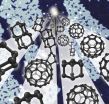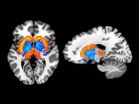(Press-News.org) Berkeley — Scientists estimate that fewer than 100 Devils Hole pupfish remain in their Mojave Desert home, but a conservation biologist at the University of California, Berkeley, is giving important guidance in the efforts to rescue them by establishing a captive breeding program.
Considered the world's rarest fish, with one of the smallest geographic ranges of any wild vertebrate, the tiny pupfish (Cyprinodon diabolis) – about one-inch long as an adult – neared extinction in spring 2013 when populations dropped to an all-time low of 35 observable pupfish. While more recent fish counts showed some recovery, the species is considered critically endangered.
The dire situation spurred the U.S. Fish and Wildlife Service to open the Ash Meadows Fish Conservation Facility, which is less than a mile from Devils Hole. Previous attempts to establish refuge populations of pupfish have not fared well, either because the transplanted fish did not survive or because they cross-bred with other species of pupfish. Biologists from the agencies managing the pupfish captive breeding program wanted a risk assessment to determine which methods have the highest chance of success.
A risk analysis by Steven Beissinger, UC Berkeley professor of environmental science, policy and management, found that when it came to reducing impact on the wild population, it was better to transfer pupfish eggs to a captive breeding facility rather than adults, and that it was preferable to transfer fish in the fall, when the population tends to be larger, rather than in the spring.
In addition, Beissinger found that moving more than six adults per year for three consecutive years rapidly increases the risk of extinction. The results, to be published online on Tuesday, Sept. 9, in the open-access journal PeerJ, showed that the wild pupfish faces a 28 to 32 percent risk of extinction over the next 20 years.
"The study really puts out more empirically the risk of extinction for this fish," said Kevin Wilson, an aquatic ecologist at Death Valley National Park who is working on the recovery of the pupfish. "These findings are providing us with very good tools for our toolbox."
Tiny survivor in an extreme environment
The pupfish is found only in a limestone cavern in the Devils Hole geothermal pool, about 60 miles east of Death Valley National Park. Geologists estimate that the cavern, which is at least 426 feet deep, was formed more than 500,000 years ago. The pupfish are believed to somehow have gained access to the site less than 50,000 years ago when a roof of the cavern collapsed, possibly due to an earthquake, exposing the cavern and its water to the ground surface. The oxygen-poor water in Devils Hole stays a toasty 92-93 degrees Fahrenheit, around the upper limits of temperature tolerated by most fish.
A study published last month found that climate change is contributing to the warming of the water in Devils Hole, negatively affecting the ability of eggs to hatch and larvae to survive. Pupfish populations also may have declined due to reductions in food supply and genetic diversity.
"Some species are critical to conserve because they serve important functions in their ecosystems, and others are important because they might be sources of new medicines, or they may have unique biological features that could inspire human innovation," said Beissinger. "We don't know if the Devils Hole pupfish has or ever will serve any of these important functions, which seems unlikely as long as the species remains restricted to its single cavernous refuge. We do know that the pupfish, like all species, has a fundamental right to exist that is independent of its value to humans."
The Devils Hole pupfish first was identified in 1930. In 1967, it was among the first species listed under the Endangered Species Preservation Act – which later became the Endangered Species Act – and thus became central in the arid Southwest water rights battles of the 1960s and '70s. The pumping of groundwater by agricultural interests and land developers in the region lowered the water levels needed by the pupfish to feed and breed. A landmark 1976 U.S. Supreme Court environmental rights ruling favored the fish and other species in Devils Hole by requiring the maintenance of a minimum level of water, thereby curtailing groundwater pumping.
"The effort to save the pupfish resulted in the protection of aquatic ecosystems from the excessive pumping of groundwater throughout the Desert Southwest and inspired generations of conservationists," said Beissinger.
California condor moment?
Beissinger also calculated that if the wild Devils Hole pupfish numbers become small enough, it may be necessary to remove the entire population into a captive breeding program, an extreme measure he called a "California condor moment" because such a controversial action was used to rescue the condor from extinction in 1986.
He noted that, unlike the slow-reproducing condor that does not breed until 5 or 6 years of age, the Devils Hole pupfish has the potential for faster population growth because it matures quickly and can reproduce multiple times in its first year of life.
"Somehow, this handsome little fish has heroically persisted in the harsh desert environment through thousands of years of drastic climate warming and droughts," said Beissinger. "Should the human condition ever arrive at this point after another century of increasing carbon dioxide emissions and climate warming, we may need someone to help us out of our hole."
INFORMATION:
The National Park Service helped fund this research.
Biologists try to dig endangered pupfish out of its hole
Fewer than 100 pupfish remain in Devils Hole, near Death Valley
2014-09-09
ELSE PRESS RELEASES FROM THIS DATE:
Tracing water channels in cell surface receptors
2014-09-09
G protein-coupled receptors (GPCRs) are the largest class of cell surface receptors in our cells, involved in signal transmission across the cell membrane. One of the biggest questions is how a signal recognized at the extracellular side of a GPCR induces a sequence of conformational changes in the protein and finally evokes an intracellular response. EPFL scientists have now used computer modeling to reveal in molecular detail the structural transitions that happen inside GPCRs during the signal transduction process. They discovered that a central step in the trans-membrane ...
Shift in Arabia sea plankton may threaten fisheries
2014-09-09
A growing "dead zone" in the middle of the Arabian Sea has allowed plankton uniquely suited to low-oxygen water to take over the base of the food chain. Their rise to dominance over the last decade could be disastrous for the predator fish that sustain 120 million people living on the sea's edge.
Scientists at Columbia University's Lamont-Doherty Earth Observatory and their colleagues are the first to document the rapid rise of green Noctiluca scintillans, an unusual dinoflagellate that eats other plankton and draws energy from the sun via microscopic algae living within ...
Buckyballs and diamondoids join forces in tiny electronic gadget
2014-09-09
Menlo Park, Calif. — Scientists have married two unconventional forms of carbon – one shaped like a soccer ball, the other a tiny diamond – to make a molecule that conducts electricity in only one direction. This tiny electronic component, known as a rectifier, could play a key role in shrinking chip components down to the size of molecules to enable faster, more powerful devices.
"We wanted to see what new, emergent properties might come out when you put these two ingredients together to create a 'buckydiamondoid,'" said Hari Manoharan of the Stanford Institute for Materials ...
Eating habits, body fat related to differences in brain chemistry
2014-09-09
People who are obese may be more susceptible to environmental food cues than their lean counterparts due to differences in brain chemistry that make eating more habitual and less rewarding, according to a National Institutes of Health study published in Molecular Psychiatry.
Researchers at the NIH Clinical Center found that, when examining 43 men and women with varying amounts of body fat, obese participants tended to have greater dopamine activity in the habit-forming region of the brain than lean counterparts, and less activity in the region controlling reward. Those ...
Study sheds light on how stem cells can be used to treat lung disease
2014-09-09
Munich, Germany: A new study has revealed how stem cells work to improve lung function in acute respiratory distress syndrome (ARDS).
Previous studies have shown that stem cells can reduce lung inflammation and restore some function in ARDS, but experts are not sure how this occurs. The new study, which was presented at the European Respiratory Society's International Congress today (09 September 2014), brings us a step closer to understanding the mechanisms that occur within an injured lung.
ARDS is a life-threatening condition in which the efficiency of the lungs ...
Birth measurements could predict lung health in teen years
2014-09-09
Munich, Germany: A new study has found that factors, such as birth weight, gestational age at birth and lung function, growth and other measures at 8 years, can be used to predict lung function during mid to late teenage years.
The study, presented at the European Respiratory Society (ERS) International Congress in Munich today (9 September 2014), is part of a growing area of research aiming to understand how early life factors have an impact on the development of disease into adulthood.
Data out of the Avon Longitudinal Study of Mothers and Children (ALSPAC) from ...
Idiopathic pulmonary fibrosis cases linked with asbestos exposure
2014-09-09
Munich, Germany: A proportion of idiopathic pulmonary fibrosis (IPF) cases may be linked with asbestos exposure, according to the results of a new study. If confirmed, the findings would mean that current treatment strategies need to be altered as people with a history of asbestos exposure are not currently able to access new treatments for IPF.
The research, which was presented at the European Respiratory Society's International Congress today (09 September 2014), provided new mortality data for IPF, asbestosis and mesothelioma.
Asbestosis is the name given to the ...
Milestone reached in work to build replacement kidneys in the lab
2014-09-09
WINSTON-SALEM, N.C. – Sept. 9, 2014 – Regenerative medicine researchers at Wake Forest Baptist Medical Center have addressed a major challenge in the quest to build replacement kidneys in the lab. Working with human-sized pig kidneys, the scientists developed the most successful method to date to keep blood vessels in the new organs open and flowing with blood. The work is reported in journal Technology.
"Until now, lab-built kidneys have been rodent-sized and have functioned for only one or two hours after transplantation because blood clots developed," said Anthony ...
Intervention in 6-month-olds with autism eliminates symptoms, developmental delay
2014-09-09
Treatment at the earliest age when symptoms of autism spectrum disorder (ASD) appear – sometimes in infants as young as 6 months old – significantly reduces symptoms so that, by age 3, most who received the therapy had neither ASD nor developmental delay, a UC Davis MIND Institute research study has found.
The treatment, known as Infant Start, was administered over a six-month period to 6- to 15-month-old infants who exhibited marked autism symptoms, such as decreased eye contact, social interest or engagement, repetitive movement patterns, and a lack of intentional communication. ...
Contrast-enhanced CT scan safe for most patients
2014-09-09
OAK BROOK, Ill. – According to new research performed at the Mayo Clinic, iodine-based contrast material injected intravenously to enhance computed tomography (CT) images can be safely used in most patients. The study appears online in the journal Radiology.
Of the 80 million or more CT scans performed each year in the United States, iodine-based contrast material is used in at least half to enhance computed tomography (CT) images, according to researcher Robert J. McDonald, M.D., Ph.D., a radiology resident at the Mayo Clinic in Rochester, Minn.
According to Dr. McDonald, ...
LAST 30 PRESS RELEASES:
Germline pathogenic variants among women without a history of breast cancer
Tanning beds triple melanoma risk, potentially causing broad DNA damage
Unique bond identified as key to viral infection speed
Indoor tanning makes youthful skin much older on a genetic level
Mouse model sheds new light on the causes and potential solutions to human GI problems linked to muscular dystrophy
The Journal of Nuclear Medicine ahead-of-print tip sheet: December 12, 2025
Smarter tools for peering into the microscopic world
Applications open for funding to conduct research in the Kinsey Institute archives
Global measure underestimates the severity of food insecurity
Child survivors of critical illness are missing out on timely follow up care
Risk-based vs annual breast cancer screening / the WISDOM randomized clinical trial
University of Toronto launches Electric Vehicle Innovation Ontario to accelerate advanced EV technologies and build Canada’s innovation advantage
Early relapse predicts poor outcomes in aggressive blood cancer
American College of Lifestyle Medicine applauds two CMS models aligned with lifestyle medicine practice and reimbursement
Clinical trial finds cannabis use not a barrier to quitting nicotine vaping
Supplemental nutrition assistance program policies and food insecurity
Switching immune cells to “night mode” could limit damage after a heart attack, study suggests
URI-based Global RIghts Project report spotlights continued troubling trends in worldwide inhumane treatment
Neutrophils are less aggressive at night, explaining why nighttime heart attacks cause less damage than daytime events
Menopausal hormone therapy may not pose breast cancer risk for women with BRCA mutations
Mobile health tool may improve quality of life for adolescent and young adult breast cancer survivors
Acupuncture may help improve perceived breast cancer-related cognitive difficulties over usual care
Nerve block may reduce opioid use in infants undergoing cleft palate surgery
CRISPR primes goldenberry for fruit bowl fame
Mass General Brigham announces new AI company to accelerate clinical trial screening and patient recruitment
Fat tissue around the heart may contribute to greater heart injury after a heart attack
Jeonbuk National University researcher proposes a proposing a two-stage decision-making framework of lithium governance in Latin America
Chromatin accessibility maps reveal how stem cells drive myelodysplastic progression
Cartilaginous cells regulate growth and blood vessel formation in bones
Plant hormone allows lifelong control of proteins in living animal for first time
[Press-News.org] Biologists try to dig endangered pupfish out of its holeFewer than 100 pupfish remain in Devils Hole, near Death Valley





